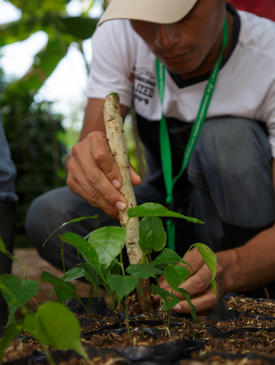Tropical Forest Restoration Strategies for Human Dominated Landscapes
Summary
Biodiverse tropical ecosystems of Latin America are under the constant strain of having to sustain human livelihoods and land-use practices such as agriculture and livestock. These human-dominated landscapes are more fragmented, have less biodiversity, produce few ecosystem services and are more vulnerable to the threats of climate change. Tropical forest restoration provides an opportunity to transform these degraded areas into resilient landscapes that provide ecological and social benefits. While in recent years valuable information has been generated in restoration research, it has not been effectively transmitted to the various stakeholders that influence the management of landscapes. In fact, within Latin America there is a great need for training opportunities to help guide informed decision making about the management, use and restoration of tropical forests. Therefore, since 2006 ELTI has been facilitating conferences and training courses in order to provide stakeholders with the knowledge and tools to conserve and restore forests in the tropical regions of Latin America and Asia. For decision makers working in agricultural mosaic landscapes in Latin America, ELTI has developed a field course that provides participants with the practical basis necessary to design and implement conservation and restoration strategies to increase the biodiversity and resiliency of landscapes.
This six-day course will be facilitated for Latin American decision makers whom have been awarded a Russell E. Train Education for Nature (EFN) Reforestation Grant from the World Wildlife Fund (WWF) and will be conducting reforestation projects in their individual communities with the goal of restoring biodiversity and enhancing human wellbeing in degraded forest landscapes. Participation is by invitation only.
Content
Module 1: Tropical dry forest ecology
- The role of forests to provide ecosystem services
- Forest dynamics, succession and natural regeneration
- Methods for monitoring ecosystem services
Module 2: Limitations for the restoration of tropical dry forests
- Climate change and regional drivers of deforestation and forest degradation
- Ecological and social consequences of degradation
- Challenges and barriers for forest restoration
Module 3: Strategies for restoring ecosystem services in agricultural landscapes
- Clarify restoration goals and appropriate restoration models
- Conceptual restoration model and tailoring strategies for biophysical and social contexts
- Forest restoration methods (range of restoration activities: Passive - Active)
Module 4: The role of community organizations in forest restoration
- The development and dynamics of community-based associations
- Financing, implementing and managing restoration projects
- Communication strategies to disseminate projects to other stakeholders
Module 5: Final exercise: Developing a plan for forest restoration
- Defining restoration objectives and identifying biophysical and social variables
- Selecting adequate restoration strategies
- Methods for monitoring restoration activities


